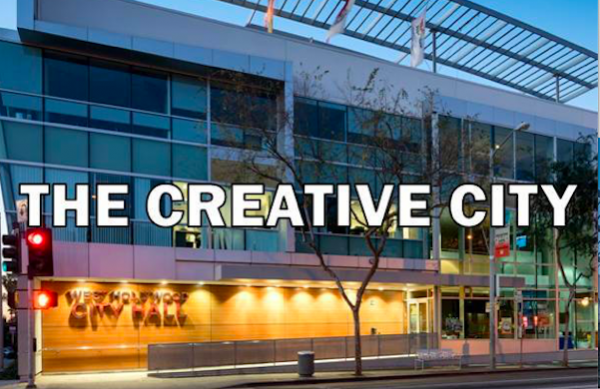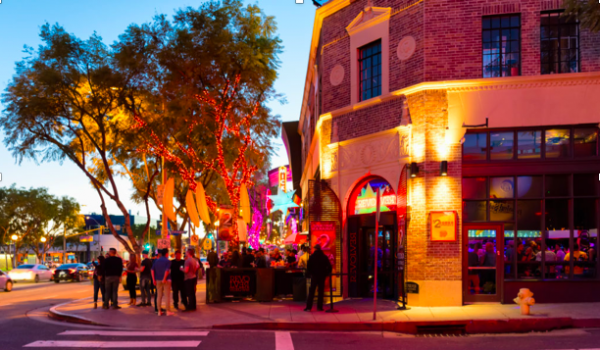
Just three years after cityhood in 1984, West Hollywood shifted identities — from being known informally as the “Gay Camelot” to officially becoming the “Creative City.” The tag line, part of a national marketing campaign, helped spruce up the city’s image for people who had little interest in gay bars, and who also may have viewed the place as unstable.
Businesses and residents readily bought into the campaign and its new moniker –everyone but gay activists, that is. They were angry because, well, it wasn’t all about them. They had a point – the Creative City strategy deliberately downplayed the significance of a sizeable homosexual population, as well as many gay-owned businesses, in favor of reaching out to general audiences throughout the country.
This approach stung because gays and lesbians had been pivotal to the successful incorporation drive, as well as in electing a city council with a majority of openly gay members – a first in U.S. political history. Those events taken together meant that “West Hollywood’s mere existence is significant to an LGBT community far beyond the boundaries of Doheny and La Brea,” prominent gay civil rights activist and author David Mixner told the L.A. Weekly in 2004. “It’s a significant part of our political history. It was a political Stonewall.”
Gay activists, led by Frontiers magazine editor Robert Craig and City Councilmember Steve Schulte, wanted the city’s first-ever marketing campaign to reach out to gay audiences too. Craig, by the way, is credited with coining the “Gay Camelot” nickname. It came from a line he plugged into a pro-cityhood speech he delivered near Election Day. “I would suggest that if you are gay, Camelot is on the horizon,” a 1994 L.A. Times article states.
Three years into cityhood, West Hollywood had an image problem, so the City Council put the people and tools in place for a marketing campaign beginning in 1987.
Boosting the City’s Image
“West Hollywood was known as a community in turmoil in the early years,” a Los Angeles Times story from 1988 states. “The City Council (with a majority of gay members) canceled Christmas as a paid holiday while enacting a tough rent-control law and stringent development guidelines that alienated business interests. Later, its first mayor, a lesbian activist, was convicted of embezzling funds from a social service agency she headed,” the article recounts.
The City Council formed the nonprofit West Hollywood Marketing Corporation – an innovation and one of the few of its kind in the country at the time. “We felt we had to do something to tell the world what West Hollywood is, because it was completely misunderstood,” Ronald S. Kates, who chaired the corporation, told the newspaper. ”Our job was to take the creative city it has always been and market that concept.”
Research showed that more than 40% of West Hollywood’s economic activity was derived from creative industries such as fashion, food and the arts. Marketers decided to promote the city as “an artistic and avant-garde area that legitimately could be compared with New York’s Greenwich Village and the Left Bank in Paris.” The goal: Draw free-spending tourists to local restaurants, clubs and stores while giving residents a stronger sense of community.
Councilmember Schulte recalled that in the beginning, “The corporation was reacting to some of the city’s negative images as a place that moved on political serendipity, a place that was too liberal, too concerned about social policy … and not about the economics of running the city.”
That changed soon enough. Within two years, the marketing group produced a stream of brochures, banners, advertisements and catalogues trumpeting West Hollywood as the place “where creativity gets down to business.”
City Manager Paul Brotzman cited the marketing corporation’s success in pointing out that sales tax revenues jumped from $6 million to $6.5 million between fiscal 1986 and fiscal 1987. During that same period, hotel tax receipts rose from $3.1 million to $3.7 million.
There also was recognition in national publications such as Adweek, which credited West Hollywood with being at the cutting edge of city marketing. The campaign accentuated the upscale aspects, such as the Sunset Strip and pricey furniture stores along Robertson Boulevard.
The Gay Issue
For all of its success, the effort angered gay leaders who felt the corporation focused far too much on the glamour and far too little on the homosexual community. Schulte told the Times, “I would like to see them acknowledge that a lot of the businesses in West Hollywood are gay-owned. They have not marketed to a gay audience, and they need to do more of that.”
The marketing corporation struggled with the issue from its inception. “The marketing team is dedicated to broadening the city’s image but cannot afford to offend a powerful portion of the community,” Executive Director Rick Cole said. He gave an example of the predicament the corporation faced: Cole said he “rejected a citizen’s serious suggestion that the corporation sponsor a ‘Queen for a Day’ contest for transvestites.”
City Manager Brotzman supported the marketing corporation, saying “The council wanted to create the corporation to market the community as a whole, not to downplay the gay businesses and people. There is, without question, a clear recognition that the gay community makes a significant contribution to this community, and that needs to be pointed out. But there is also recognition that gays represent about 25% of the community, and that there is a lot more here. And that also needs to be shown.”
A compromise of sorts was reached when Councilman John Heilman arranged a meeting in June 1988 between gay activists and the marketing corporation that led to new approaches. He said afterwards that marketers would do targeted advertising to the national gay and lesbian community, as well as develop a gay and lesbian visitor’s guide.
Big Changes
By 2009, the situation had completely reversed itself. West Hollywood was eager to shore up revenues after the Great Recession began a year earlier. Its goal this time: Market the city as a vacation destination for gays and lesbians.

The LGBTQ section of the Visit West Hollywood website today emphasizes attractions and activities for gay audiences.
The campaign was spearheaded by a redesigned travel website – GoGayWestHollywood.com – that included a list of hotels, clubs, bars and nighttime happenings under the auspices of the West Hollywood Marketing & Visitors Bureau.
“Even in a slumping economy, gay and lesbian tourists tend to wield more disposable income and are more likely to spend on travel and leisure than heterosexual tourists,” the Los Angeles Times noted in an article Nov. 2, 2009. The city commissioned a study in 2007 that found gay and lesbian tourists were expected to spend on average $2,300 for vacations during the spring and summer whereas heterosexual travelers planned to spend on average $1,500 for the same period.

It was a smart move to call West Hollywood “The Creative City”. Being called the “Gay Camelot” would have help tourism and community pride in the beginning,but would have pigeon holed the city as being just for gay people.It would have limited the city vision in many visitors’ eyes and would become a place to avoid. Not something you want if you are looking to expand and attract new people. Look at Laguna Beach that was considered very gay twenty or thirty years ago.It had a visible gay population that was very creative. Witness the Festival of Arts,the Sawdust Festival,… Read more »
Thank you, Bob! I moved to Los Angeles in 1988 to attend USC Cinema and recall attending an event celebrating the City’s five-year anniversary sometime in 1989. Although I’d been making my way from University Park to Rage, Revolver, and Mother Lode for the better part of a year, it wasn’t until that night that I got what West Hollywood is and its unique status among the gayborhoods of the world. The gays and lesbians are in charge! A resident now for over 25 years, I find myself wishing I’d paid more attention back then, especially now as we chart… Read more »
Thanks Bob for the thoughtful commentary about the challenges of the past which only remind us that West Hollywood faces similar challenges about our image today.
If WeHo wants to market itself as a vacation destination for gays I have two suggestions: 1.) The bars have been a disappointment to tourists who I have talked to. They are too tame! They have heard or have remembered from times past when go-go boys really gave a good show. The old Here Lounge on Wednesday nights, Mickey’s, and Fubar, which was the last hold-out, are just no fun anymore. The customers want more and they’re being “tantalized”, the dancers are willing and want to make more in tips, but, no, because now there are “rules”. The Abbey with… Read more »
All of the TMZ, (thirty mile zone) is considered “creative” due to the movie and television industry and Hollywood. So for us to call West Hollywood the “Creative City” is just lumping us into the rest of the area. We should call ourselves the “Progressive City” and earn that name by becoming one of the “Safe Cities” in America, having state of the art security measures, like consistent crosswalks, public cameras, etc. diversity on City Council, welcoming diversity like having a black history month celebration, providing earthquake survival kits and at least 5 gallons of emergency water. to all residents,… Read more »
With John Duran hanging on to his tarnished political position, West Hollywood should be called the #antiwetoo City!